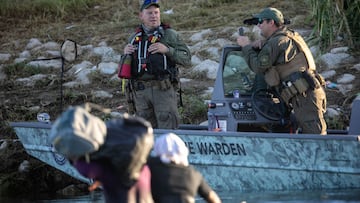What is the salary of US border patrol agents?
Horrific videos and images of CBP agents treating Haitian migrants with a blanket disregard for their well-being have prompted an investigation.


The horrific scenes captured at the Southern border where Customs and Border Patrol (CBP) agents were seen using their horses to corral and scare Haitian migrants prompted criticism from immigrants and human rights activists.
This behavior and allegations that the agents used their reins to control their horses as whips are being investigated by the Department of Homeland Security.
Regardless of the allegations of whipping, the video footage clearly shows that agents used their horses to intimidate and disburse crowds that included children. Agents were also captured, yelling profanities and racist comments at the migrants.
Border Patrol agents on horseback were seen using whips and horses to block the path of incoming asylum seekers during one of the busiest immigration seasons in decades. pic.twitter.com/wvR9smX15O
— AJ+ (@ajplus) September 23, 2021
Secretary of Homeland Security Alejandro Mayorkas called the footage “troubling” and reaffirmed the commitment of DHS to “processing migrants in a safe, orderly, and humane way. We can and must do this in a way that ensures the safety and dignity of migrants.”
However, these comments have not quelled criticisms from immigration activists and some policymakers that question the utility and efficiency of agents and CPB more widely. One question on the minds of many after this incident was how much these agents make.
As of June 2021, the starting salary for a Border Patrol Agent ranged between $49,508 and $78,269, commiserate with experience. Within a few years, however, the salary can reach more than $100,000. Agents are also offered generous benefits, just like other federal workers. These include paid sick leave, federal holidays, and high-quality health insurance, and government retirement accounts.
How many border patrol agents are there?
The Department of Homeland Security (DHS) was established after the events of September 11th. Customs and Border Patrol had previously been split under the Departments of Justice and Labor but was moved to the DHS after its creation.
In 1992, there were 4,139 CBP agents. By 2003, that figure had grown to 10,717. Today, it is nearly double, standing at 25,756. Under President Obama, this number grew and then decreased, only to be increased once again under President Trump.
Most of these agents are stationed at the Southern border, a historical trend that has persisted as the force has grown. In 2016, around 84 percent of agents could be found there.
A brief history of enforcement at the Southern border
This is what it takes to get from Haiti to the U.S.
— AJ+ (@ajplus) September 26, 2021
The Del Rio camp housing Haitian asylum seekers has been cleared. Here's an inside look at what they endured during the years-long journey in search of a better life. pic.twitter.com/Cw4WJLiqgJ
While the United States has long claimed to be a "refuge" for migrants. The Statue of Liberty is enshrined with a poem that reads: "Give me your tired, your poor, Your huddled masses yearning to breathe free."
However, many migrants, regardless of their point of entry, have been met with racist and dehumanizing treatment. This is especially true with migrants hoping for a better life in the land of opportunity from the Southern border. While the media has taken to covering the violence inflicted on migrants at the Southern border in greater depth in recent years, it has been happening for more than a century.
It is not the violent practices that have changed, only the origin of the victims who experience it.
In the early 1900s, the US Department of Commerce began to hire "mounted watchmen" to patrol the Southern Border, some of whom were Texas Rangers. The Texas Rangers have a long and violent past but were seen as highly effective in preventing migrants from entering the US.
Before taking on immigration enforcement, one historian, Doug Swanson, found that just after Texas was annexed by the US, the Rangers "hunted runaway slaves and murdered so many Mexicans and Mexican Americans that they were as feared on the Mexican border as the Ku Klux Klan was in the Deep South."
Swanson highlights that this history happened just over one hundred years ago and that today we would call the Rangers "death squads" based on the actions they carried out. This included the mass murder of Mexican Mexicans and Mexican Americans, "some of those were bandits who had attacked white-owned farms and ranches, but many of them had committed no crimes. You know, they were guilty of having brown skin."
The Texas Rangers were one of the groups tasked with preventing illegal crossings in 1904, primarily to track down Chinese migrants who were prevented from entering the country due to discriminatory immigration quotes detailed in the Chinese Exclusion Act.
Over the years, leaders from the Texas Rangers have been invovled in shaping CBP, a fact left out of the Department of Homeland Security brief history of the agency. The history posted on DHS's website reads that in the early days, Rangers were "sporadically assigned to patrol duties by the state, and their efforts were noted as "singularly effective."
While CPB grew into a formal institution within the immigration enforcement governing apparatus, the practices and links to the Texas Rangers were not cut. Still today, the Rangers support the Texas Department of Public Safety with enforcement and investigations.
CBP's increased presence at the Southern Border (1980 -- Present)
The history also details the responses CBP took after the "tremendous increase of illegal migration to America" in the 1980s and 1990s. To respond to the influx, CBP increased its "manpower and the implementation of modern technology. Infrared night-vision scopes, seismic sensors, and a modern computer processing system helped the Patrol locate, apprehend, and process those crossing into the U.S. illegally."
The history details how effective these methods were, noting how various operations led to a "drastic reduction in apprehensions," which allowed them to "able to concentrate on other areas, such as establishing anti-smuggling units and search and rescue teams."
However, with the increases in migration continuing, it is clear that this approach failed to address the root causes of the problems that motivate people to flee thier homeland.
During the Cold War, the United States spent the better more than fifty years touting American greatness -- spreading the message the American values and way of life are superior. Telling those abroad that the American Dream is possible even for those not born here.
The approaches taken by CBP may have been able to reduce "illegal entries in San Diego by more than 75%" in the 1990s... but should that be the metric of success? T
his approach did not prevent the deaths of children in their care.
It did not stop the sexual assaults that took place in detention centers.
And without a real strategy to address the root causes of migration, these heartbreaking events, like what was seen last week, will continue to happen.
In 1821, in exchange for finally recognizing Haiti's independence, France demanded an indemnity of 100 million francs (about $21 billion today). It took Haiti more than 100 years to pay off the debt, and kept the country mired in deep poverty.
— Gravel Institute (@GravelInstitute) September 25, 2021
DHS and CBP may argue that this is the responsibility of the State Department or USAID, but these excuses are tired. Shifting the blame does not solve the problem, but it seems to be the government's primary response to these sorts of situations.
Republican politicians may try to scapegoat immigrants by saying that they increase crime or steal jobs, but these claims just aren't backed by data. History and records tell us that the material conditions for most people living in Haiti are extremely difficult.
The Del Rio camp housing Haitian asylum seekers has been cleared, says a judge.
— AJ+ (@ajplus) September 24, 2021
▪️ About 2,000 deported, mostly women and children
▪️ About 3,900 people being processed for removal
▪️ Biden using Trump's Title 42 to deny hearings
▪️ 20 deportation flights planned through Sunday pic.twitter.com/NsT7eYqYCN
Debt, to the tune of $21 billion in today's dollars, was imposed on them by the French after they gained independence hindered the new nation's development for one hundred years.
In 2010, a 7.3 magnitude earthquake killed more than 200,000 people and left the county's infrastructure in ruin. After this event, many fled to other countries in Latin America in search of economic opportunities.
Related stories
The BBC interviewed Fiterson Janvier, who said he left Haiti in 2014 and had passed "through eleven different countries" before getting to the United States. When asked how he felt about being imminently deported back to Haiti -- the fate the majority of the migrants will face -- he said, "There is nothing for me there. Nothing. If they're going to send me back, they may as well just kill me. Just end it all."
Give me your huddled masses; yearning to breathe free is a promise made to those looking for a better life. It is a promise that the United States has failed to keep, particularly to the most desperate who make it to our border.

